The AV Club Next Generation - May 2009
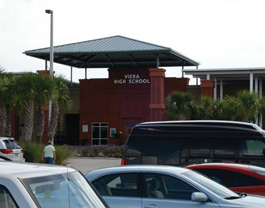
Engaging the digital natives isn’t as daunting as you think. Here’s how three classrooms do it.
A MEDIA SHOWCASE
Pete Episcopo had a vision. When he started at Brevard Public Schools in Viera, Florida, the digital-media artist wanted to share his love of all things digital and teach essential 21st-century skills so students could be better prepared for postsecondary education after high school. After filling in for a teacher and “transforming the class” by teaching PhotoShop, Illustrator and Brevard County students learn 21st-century workforce skills while studying photography, graphic design, and more in the district’s digital art academy. InDesign, he spent the summer creating a visual-design curriculum, and now his classes are among the district’s most popular.
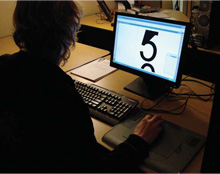
Episcopo’s students learn to use online photo libraries, scan images, take digital photos, edit audio and video files and master the world of digital storytelling with Adobe Creative Suite technology.
To expand the program, he helped the district hire graphic designer Barbara Fine, who teaches communications technology at Palm Bay High School. In her classes, students work in teams on projects
Pete Episcopo shares his digital media experience with eager students. similar to the jobs designers do. For instance, they design logos, letterheads, advertisements and home pages—what are collectively known as an identity package—for clients. They create magazine covers and movie posters and have even designed their own fonts. “The classes have exploded. Unfortunately, I have to turn students away,” Fine says.
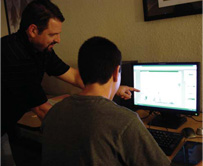
Students in the digital-media classes build electronic portfolios and create Web sites to showcase their work. Eventually, they can use the portfolios to woo potential employers. Episcopo has begun asking students to track the steps they take so they can explain to their peers how they work.
This year Episcopo helped Viera High School develop a digital- arts academy for incoming fall 2009 freshmen interested in graphic-design careers. Students who complete the four-year program will be certified in Photoshop, Dreamweaver and Flash. “The goals are to give industry certification to kids who are not going to college and to prepare college-bound students better as well,” he says. “Today digital media is used in everything from dentistry to law. We want to give them the opportunity to expand their horizons.”
Both teachers know that whatever their students eventually do—whether they become pharmacists, politicians or anything in between—digital media will be a factor in their lives. Fine and Episcopo say that the “soft skills” they teach are just as important as the software and hardware the students learn to use. “I make the projects and class as real as possible by teaching about the elements and principles of design,” says Fine. “We help students learn how to shake hands and ask Chuck Taft’s students experience history and learn 21st-century skills at the same time. SMARTBoards help his lessons have more impact. the right questions. What they learn affects the way they view the world.”
Tools and ideas to transform education. Sign up below.
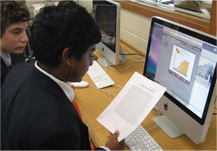
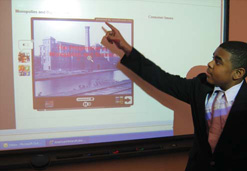
As the program continues to expand, Fine plans to teach about industry careers and essential interview skills. In addition, the Viera High School academy will feature television and film production next year. Fourth-year students will take broadcasting classes while filming their senior year for a DVD that will be bundled into the yearbook.
A gallery of Fine’s students’ work is at palmbay.hs.brevard. k12.fl.us/staffwebpgs/Fine%27s%20webpage/gallery.htm. The Web site of Episcopo’s class is at http://web.mac.com/ backyardsky.
THE FUTURE OF HISTORY
Chuck Taft could have continued to assign the same old research reports to eighth graders at the University School of Milwaukee, but he wanted to create a richer learning experience. “Social-studies teachers want students to role-play and to step outside themselves,” says Taft. “It made sense to let students collaborate and use 21st-century tools to meet objectives.”
One of Taft’s first projects focused on the history of civil rights. Students were assigned a civil-rights leader and, working alone or with a partner, set up a Facebook-like profile on Ning. The profile
From script writing to social networking, Taft’s students gain useful skills while learning about history. highlighted their leader’s education and background and answered such questions as “What is your biggest goal for the civil-rights movement?” They participated in online discussions, chatted with other “leaders” and posted video clips, articles and photos. “The project extended far into the evening most nights, and students in all my classes interacted with each other.”
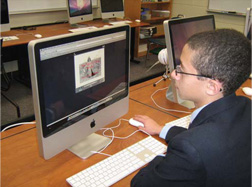
Rather than just write essays, Taft’s students collaborate on scripts using Google Docs and comment on one another’s creations via VoiceThread. They research various time periods and create “We Were There” videos and post them on YouTube. “Three students uploaded a ‘We Were There in Birmingham in 1963’ video that has been seen 12,000 times,” boasts Taft. “The user comments were both good and bad, which led to a terrific teachable moment and hopefully made the students better digital citizens. It’s the type of authentic learning they can’t get from a textbook.”
Taft credits Matt Montagne, the instructional-technology integrator at Castilleja School in Palo Alto, California, with helping him learn to devise projects that emphasize 21st-century skills. Montagne formerly worked at the University School, helping teachers spice up their classes by using podcasting, Skyping and other Web 2.0 tools. “Chuck is providing a framework for kids to be creative, show what they know and live up to his high expectations,” says Montagne. “Forcing students to think outside the box is essential because colleges and employers want those types of thinkers. Our goal is to prepare young people for their future, not our past.”
Assessment is always of concern. How do you move from individual, isolated assessments to evaluating collaborative, creative projects? Montagne is looking to fine-arts educators for a potential solution and believes he will at some point move toward a portfolio model.
Taft’s only complaint about using Web 2.0 tools to teach is that he’s constantly pressed for time. “Developing these activities and allowing kids the amount of time to really work on them is my biggest challenge,” he says. “It would be much easier to give my 45-minute PowerPoint
Franklin High principal Stacy Ely at the AV Classroom Control Panel. historical presentation and tell the same jokes every year.”
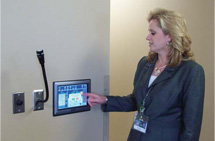
But then he’d miss out on the opportunities he’s had to connect with other educators interested in 21st-century learning through Ning, Facebook and other online platforms.
For his part, Montagne would miss having strangers view his students’ work. “I’ve been quite surprised by the reach of the digitally published student artifacts. Much of this work is two years old and is still online being viewed by other people.”
For information on the projects at Taft’s school, go to 21stcenturytoolsncss.wikispaces.com/examples.
SEEING IS BELIEVING
To some, Franklin High School in
Jill Patton’s classroom studies Africa by looking at Google Earth and landforms from satellite images. Franklin, Texas, may seem like a long way from everywhere. But thanks to an arsenal of hardware and software, Jill Patton’s ninth-grade worldgeography classroom is actually right in the middle of it all.
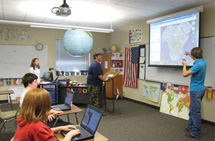
One of her favorite lessons involves letting students play an interactive online mapping game. “Using cordless mice, students go to a Web site, pick a continent and fit the country pieces into the right spots,” she says. The Web site helps them corrects their mistakes, saying, for example, “You’re off by 200 miles.” By using several modalities, the students learn the information more thoroughly, and, Patton says, their scores on map-identification tests are through the roof. “Teaching this way involves extra time on my part, but it’s worth it. They are glued to my every word in class,” she says.
Google Earth is another frequently used site. Patton’s students learned how to enter their addresses and zoom in on their houses and visit sites around the world. “Many of
Franklin High’s administrative control station. these kids have never been out of our town, left the state or been on a plane. They love using the site to learn about latitude and longitude. We use it for everything, even live-action tracking of hurricanes.”

She uses Discovery streaming as often as she can to play videos from anywhere in the room. As a visual learner herself, Patton believes that even a three-minute clip on a subject helps students retain information. “All teachers have a desktop monitor and a big screen that is really easy to control. I can be grading papers at my desk while the kids watch a video or a presentation.”
Although this has been her first full year with the upgraded technology, Patton already sees a huge difference in her students’ comprehension. “Hands down, they are doing better this year,” she says.
